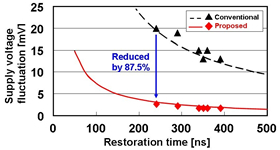Archived content
NOTE: this is an archived page and the content is likely to be out of date.
Fujitsu Laboratories Develops Power Gating Technology to Enable Power Savings in System LSIs
- Permits rapid on/off power switching in less than one microsecond, an industry first -
Fujitsu Laboratories Ltd.,Fujitsu Microelectronics
-
[1] Leakage current
Wasted current that is leaked when a circuit is idle.
-
[2] Power supply noise
Voltage fluctuations in a power supply that exert a negative influence over a LSI's internal circuit operations.
-
[3] Power-supply impedance
PA measure of the difficulty with which current flows, when supplied to a powered network. The unit of impedance is the ohm (Ω).
-
[4] CoolAdjust™
Fujitsu Microelectronics' power-saving technology that is based on power supply control. Comprised of power gating and technologies that optimize the body bias voltage and power-supply voltage, in response to process and thermal fluctuations.
-
[5] ASSP
Application-specific standard product. A general-purpose LSI featuring functions for specific applications.
-
[6] ASIC
Application-specific integrated circuit. A customized LSI for a specific purpose.
About Fujitsu Laboratories
Founded in 1968 as a wholly owned subsidiary of Fujitsu Limited, Fujitsu Laboratories Limited is one of the premier research centers in the world. With a global network of laboratories in Japan, China, the United States and Europe, the organization conducts a wide range of basic and applied research in the areas of Multimedia, Personal Systems, Networks, Peripherals, Advanced Materials and Electronic Devices. For more information, please see:http://jp.fujitsu.com/group/labs/en/
About Fujitsu Microelectronics (FML)
Fujitsu Microelectronics Limited (FML) is a large-scale integrated circuit (LSI) manufacturer that provides highly reliable, optimal solutions to meet the varying needs of its customers, through LSI offerings including ASIC/COT, ASSP and power management ICs, and flash microcontrollers. Along with building on its wide-range expertise focusing on imaging, wireless, and security LSI applications, FML also pursues initiatives for power efficiency and undertakes environmentally-conscious countermeasures. Headquartered in Tokyo, FML was established as a subsidiary of Fujitsu Limited on March 21, 2008. Through its global sales and development network with sites in Japan and other regions in Asia, Europe, and the U.S., FML offers LSI solutions to the global marketplace. For more information:http://jp.fujitsu.com/group/fml/en/
Technical Contacts
System LSI Development Lab.SOC Design Methodology Research Lab.
![]() Phone: +81-44-754-2657
Phone: +81-44-754-2657
![]() E-mail: lp-pg@ml.labs.fujitsu.com
E-mail: lp-pg@ml.labs.fujitsu.com
Company:Fujitsu Laboratories Limited
Company and product names referenced herein are trademarks or registered trademarks of their respective owners. Information provided in this press release is accurate at time of publication and is subject to change without advance notice.
Date: 17 June, 2008
City: Kawasaki and Tokyo, Japan
Company:
Fujitsu Laboratories Ltd.,
Fujitsu Microelectronics Ltd.,
,
,
,
